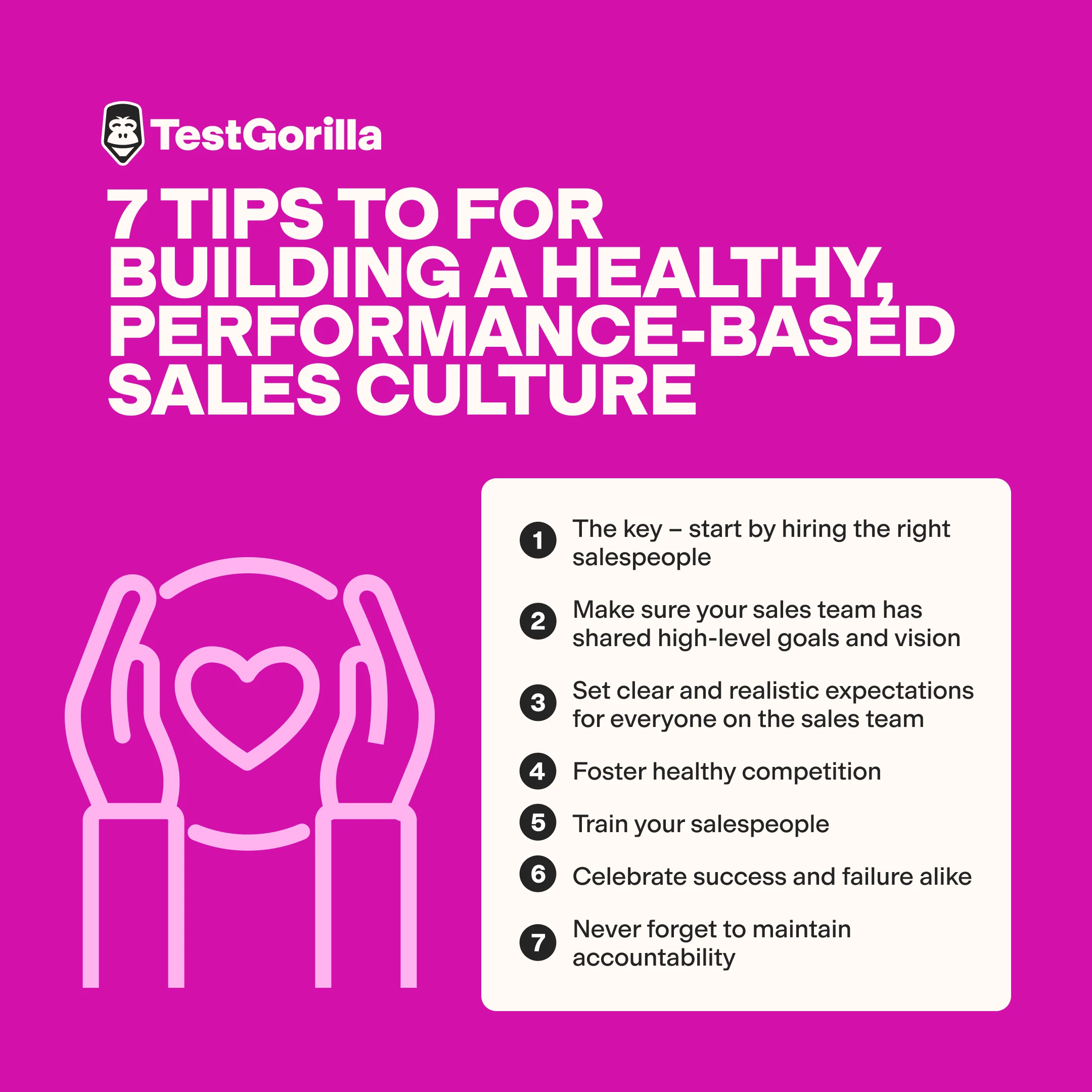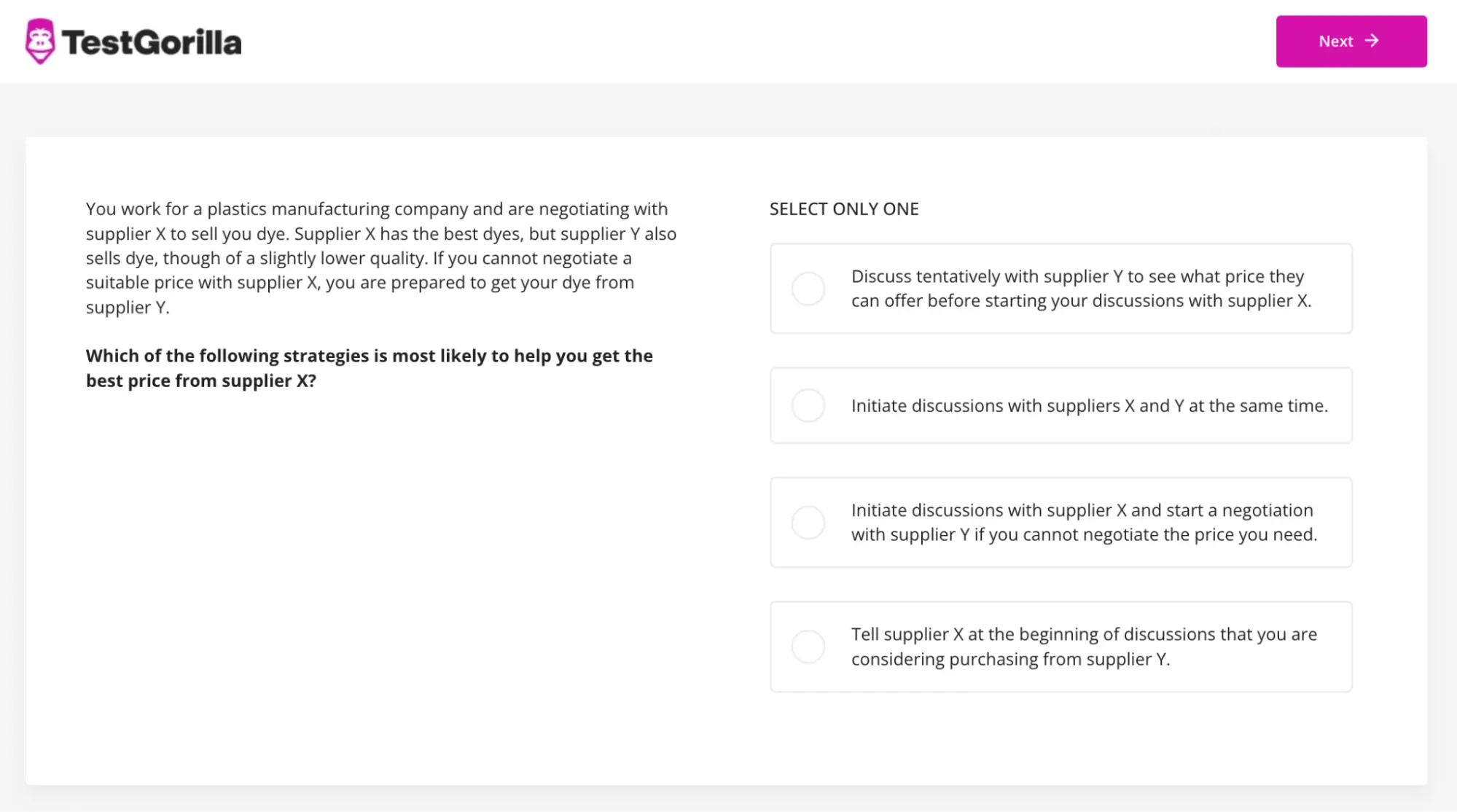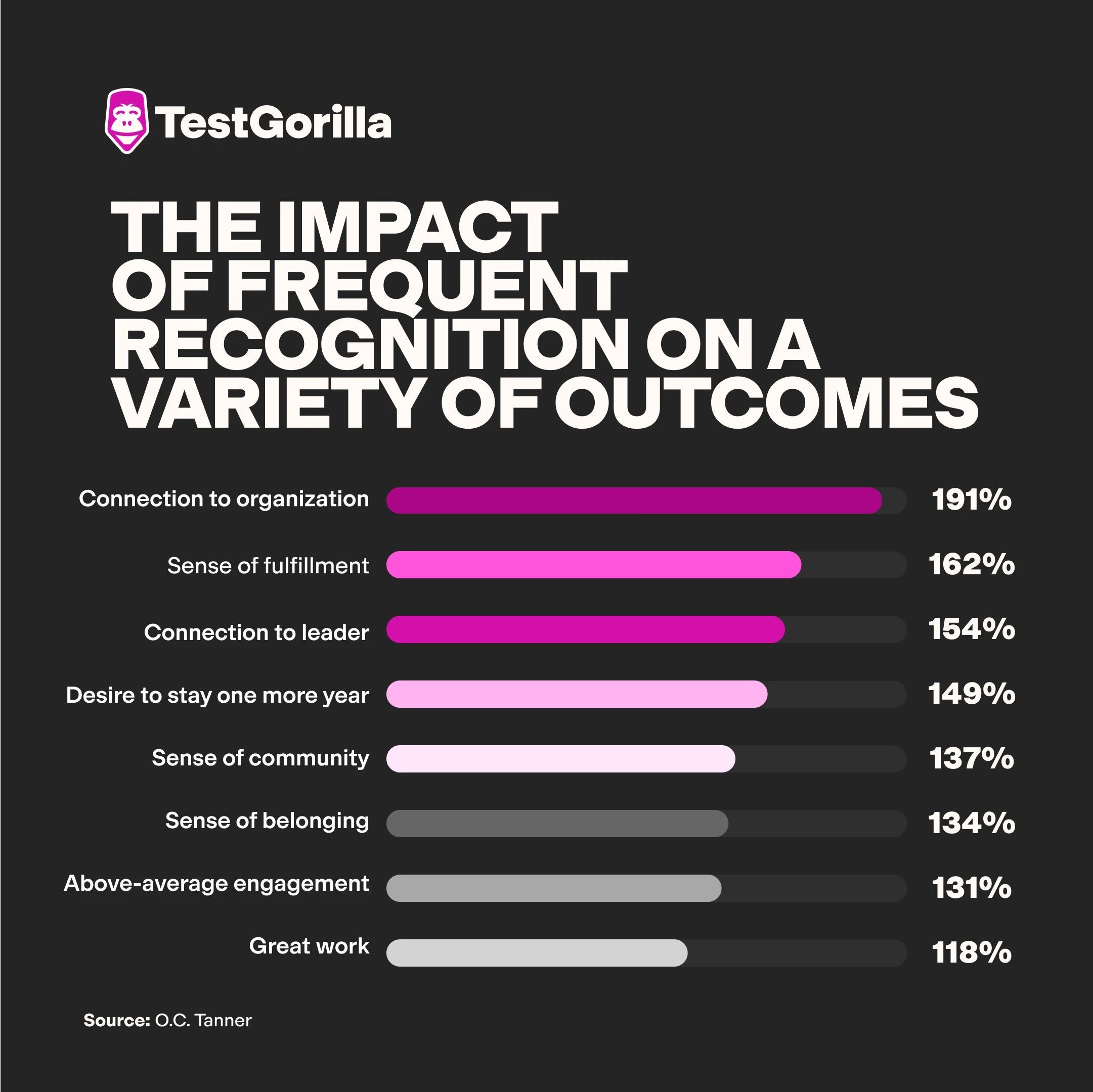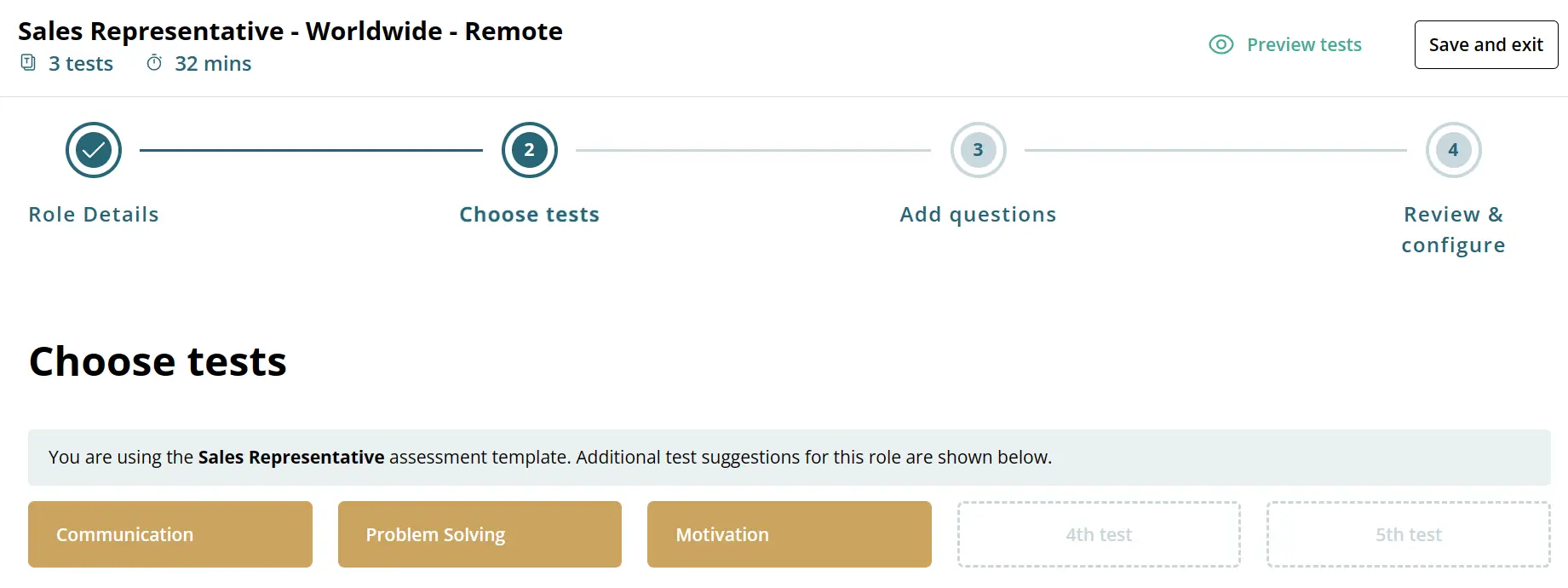How to build a healthy and successful sales culture
Hire salespeople with the right combination of skills and values
Nobody wins in a toxic sales culture. Salespeople are stressed and desperate for commission, they’re focused on vanity metrics, and business suffers as a result.
Companies with the best sales culture have more evenly matched numbers between teammates because they help each other whenever possible. They’re cooperative, supportive, and driven by values, goals, and strong ethics – not commission alone.
This type of culture leads to lasting rewards for the entire company and its sales professionals.
If your sales environment sounds more like the toxic example, don’t worry; this article explains how you can turn it around.
Table of contents
What is sales culture?
A sales culture is the qualitative summary of your entire sales department’s embodied values, behaviors, attitudes, and habits. There are no hard metrics that measure it.
Instead, sales culture may be described as “supportive” and “competitive” in a good case scenario, or “toxic” in a bad one.
We believe a solid sales culture aligns with TestGorilla’s value of “acting with integrity.” This means treating colleagues and customers alike with respect and empathy.
You can apply this value to a sales culture by:
Keeping your entire team’s interests in mind
Using your position to do what’s best for everyone
Treating others how you want to be treated
Never selling someone something they don’t need
What makes a healthy sales environment?
Creating a winning sales culture hinges on your ability to assess your organizational culture objectively.
These are the of a positive sales culture you definitely want to see in your company:
Indicator of a healthy sales culture | Explanation |
1. Collaboration | Employees help each other out instead of trying to come out on top |
2. A culture of learning at work | Fair and actionable feedback from leadership and frequent training |
3. Employee appreciation and recognition | All employees feel valued, even when they’re not breaking sales records |
4. Accountability and clear responsibilities | Employees know exactly what’s expected of them |
5. Well-balanced workloads | Everyone does their fair share but gets to rest and have a life too |
6. Fair compensation | A solid base salary so employees don’t rely solely on commission |
These factors are largely determined by leadership.
What makes a toxic sales culture?
When you don’t prioritize a positive culture, the absence of the elements we covered above is noticeable.
Andy Wallace, a manager and trainer, draws on his experience in power-based crime intervention to compare a toxic sales culture with early-stage abusive relationships.
He says they both rely on manipulation, false urgency, and making false promises.
A toxic sales culture like this impacts the entire department. Here are some signs it’s happening in your sales organization:
Indicator of a toxic sales culture | Explanation |
1. General mistrust | Poor relationships among team members and between employees and leadership – unfair or incomplete feedback and conflict might be common |
2. Individualism | Employees prioritize personal success over the success of the team and the company as a whole |
3. Unclear responsibilities and accountability | It’s not clear who’s doing what, people pass responsibilities to others, and the department always has fires to put out as a result |
4. Focus on vanity success metrics or short-sighted sales goals only | Salespeople value quick “wins” over long-term client relationships, leading to lower quality of work |
5. Too big or unbalanced workloads | Neverending workloads lead to burnout and other issues, and unbalanced workloads result in resentment between colleagues |
How to improve sales culture: 7 tips
Apply these tactics to create a healthy, performance-based work environment.
1. The key – start by hiring the right salespeople
Building a great sales culture starts with recruitment.
You can lay a solid foundation by hiring candidates who share and naturally embody your company values in their daily work.
Resumes don’t help you there. Instead, evaluate skills using sales assessment tests to engage a much larger and more diverse talent pool and fairly assess candidates based on what truly matters: skills, personality, job expectations, and culture.
With skills-based hiring, you can zero in on capabilities, reduce unconscious bias, and find the ideal candidate.
Here’s an example of a rounded skills assessment for a sales representative:
B2B Outside Sales test
Salesforce test
Negotiation test
Time Management test
Culture Add test
These and hundreds of other tests are already a part of the TestGorilla test library.
The assessment doesn’t take a lot of time, and the results are automatically compared so the best candidates come out on top. Here’s a sample question from the Negotiation test:
For more questions from this test, visit the Negotiation test preview.
ExoGroup completely overhauled its hiring process to hire the best salespeople with TestGorilla. Its previous candidate experience was long and complicated, and the company was losing good applicants. The results:
Faster, more straightforward hiring process
Spiked candidate engagement
More applicants finishing the assessments
Higher-quality insights for data-driven hiring decisions
Their recipe for salespeople evaluation includes Critical Thinking, Negotiation, Account Management, and DISC tests.
Use TestGorilla to hire the best
TestGorilla assessments streamline the hiring process. All you need to do is select the right evaluations and you get a 360-degree view of your candidates.
2. Make sure your sales team has shared high-level goals and vision
You can give your sales team a bigger reason to come to work with a shared vision and objectives.
Team goals and a collective mission help everyone feel like they’re contributing to something meaningful other than their monthly paycheck.
A sense of purpose and buy-in is especially important to Gen Z employees, who perceive it to be as big of a priority as wellbeing benefits and a positive work culture.
High-level goals improve:
Morale
Motivation
Teamwork and collaboration
Engagement
High-level goals can be anything, such as “improve cold email personalization” or “become industry thought leaders,” as long as they’re aligned with the overall business and marketing goals.
Shared sales strategies can be communicated in team meetings, email surveys, and via a group chat program like Slack.
3. Set clear and realistic expectations for everyone on the sales team
Unrealistic expectations are a huge cause of employee burnout.
Setting realistic quotas, deadlines, and even workloads between employees promotes better performance and reduces undue stress.
It also prevents thoughts of favoritism.
Bruno, a member of our sales team, is happy that TestGorilla’s sales culture takes a support-based rather than threat-based approach to target achievement.
He goes on to say that some sales teams are regrettably always scared of being fired for not hitting quota. The sales team at TestGorilla supports each other to ensure everyone hits their targets.
4. Foster healthy competition
There is a big difference between healthy and toxic competition.
Unhealthy competition is born from scarcity, fear, hierarchic relations, and the need to win at all costs.
Healthy competition helps engage and motivate salespeople to do their best and promotes a high-performance sales culture.
Here are a few ideas to foster positive competition in your sales processes:
Gamification
Team-wide sales contests and incentives
A mix of individual and team recognition and rewards
Mentoring and sales coaching
Encouraging sales reps to beat their own numbers instead of other team members’
You can also choose a “common enemy,” like an external competitor, instead of pitting salespeople against each other. Your reps then spend more time working together to beat another company’s numbers and not focus on each other.
5. Train your salespeople
Top sales performers aren’t born with secret sales knowledge that others can’t learn. Here are two important reminders if some people on your team are consistently doing better than others:
Turn their wins into masterclasses for the whole department to learn and improve
Don’t let their star status stop you from honing their sales skills too, or they’ll stagnate
It’s the best-case scenario for the company to have a high-performing sales team with everyone functioning at a similar level.
To close the gaps, facilitate regular sales training across the department, including both hard skills like CRM proficiency and soft skills like communication. Learning and development at work ensures:
Training actually gets done because it’s built into work and doesn’t require employees to sacrifice precious free time
Knowledge and skills disparities are small and manageable
Everyone gets a fair shot at improving and earning the “top performer” achievement, including those who wouldn’t get access to such opportunities otherwise
You don’t have to worry about anyone breaking compliance and business ethics and getting the company in trouble
Your talent keeps improving, and your quality of work keeps rising
The company maintains its internal mobility and flexibility so you can handle whatever the future brings your way
6. Celebrate success and failure alike
According to O.C. Tanner, 80% of employees globally feel unappreciated and undervalued despite being essential to business success.
Don’t let that be your organization’s sales culture.
Celebrating small victories makes a huge impact – 72% of employees with great recognition experiences state this is a regular part of their culture.
Make sure your team feels appreciated for their hard work. Celebrate success with special lunches or parties, take the team out for dinner, or give them a shout-out on LinkedIn or the company intranet.
Regular appreciation has far-reaching effects:
Another important point is learning from failure.
Nobody likes hearing their performance was subpar. Hearing this can cause employees to feel shame and fear of losing their jobs.
Turn mistakes into continuous learning and growth opportunities, not excuses to chastise your sales team. When you provide constructive feedback with empathy and open a discussion, salespeople can learn from their mistakes and not fear them.
You can make it easier by:
Encouraging sales leaders to share their failures and nurture a culture in which failure is a learning experience, not a catastrophe
Celebrating small wins and dedicated effort, not only sales outcomes, so employees remain motivated to improve
Providing ample coaching and chances for improvement to lower performance anxiety
7. Never forget to maintain accountability
Poor behavior, such as yelling, mocking, lying, or excessive bragging, needs to be addressed and corrected on the spot.
The stakes are high: Research shows that one person’s unaddressed toxic behavior is enough to make the entire department unhappy and ruin team cohesiveness.
Don’t tolerate it.
Your company policies, performance reviews, and real-time actions need to align and consistently send the same message.
Follow these steps to facilitate accountability company-wide:
Clearly define expectations and the consequences of falling short: Specify what is considered positive or negative behavior and what each leads to
Provide examples of desirable and undesirable behavior: Talk about different scenarios instead of waiting until they happen
Clearly define deadlines: State when employees have to finish tasks or correct behaviors before there are consequences
Apply accountability on all levels equally and consistently: Ensure sales managers aren’t any more justified in lying or bullying than their subordinates
Remember to announce any new rules, especially if it’s a big and sudden change from your old business as usual.
This way, everyone gets a fair warning and a chance to correct their behavior.
Build a better sales team with TestGorilla
Creating a high-performance sales culture is much easier when you and your employees are on the same page from day one. Motivating them becomes second nature, your sales environment meets their needs, and their behavior aligns with your values.
In addition, you spend fewer resources on adjustments and have greater chances for a happy long-term collaboration.
But it takes more than previous sales role experience to tell a great candidate apart and guarantee a good hire.
Using talent assessments, you can find salespeople who already have the abilities, mindset, and motivation to thrive in your culture.
We have an in-depth article about the traits to look for and how to evaluate salespeople.
All you need to get started are the right tests.
When you begin creating a custom assessment in TestGorilla, you get test recommendations that might fit the job description:
It shows relevant and perhaps less obvious options to consider, such as the Motivation test.
This test shows the alignment between your candidates’ expectations and your job offer. Unlike hard skills, which you can train, candidates’ innate preferences and motivators don’t tend to change significantly.
That’s why strong matches indicate better performance and longer retention rates.
TestGorilla assessments can be further customized and help with building a successful sales team culture:
With customizable qualifying questions to disqualify poor matches
Using one-way interviews to save you recruiting hours
By enabling you to add your own tests to the mix and ensure even the most specific or niche role criteria are met
Our Client Contentoo finds talent assessments to be crucial in limiting bias and emotions, customizing the benchmarks for hiring, and making data-driven hiring decisions.
Unlock the power of skills-based hiring with TestGorilla talent assessments
Using TestGorilla is quick and easy. Sign up for a 100% free plan and start crafting the perfect sales assessment today.
A healthy sales culture starts with hiring great people
A positive sales culture that promotes support, camaraderie, and teamwork changes a “bad job role” to a “great job role,” reducing turnover and burnout.
Creating a winning sales culture starts with hiring the right candidates.
It can be easy – watch the TestGorilla demo or product tour to see for yourself.
Next, take advantage of your Free forever plan to assess your sales candidates quantitatively, streamline the hiring process, and find the perfect match to your company culture and job description!
Sales culture FAQs
Below are the answers to the four commonly asked sales culture questions.
What does a sales culture look like?
A positive sales culture might be described as supportive, competitive, transparent, performance-based, and collaborative. A negative culture can be toxic, cutthroat, and stressful.
How do you drive a selling culture?
Rally the team under shared goals
Make sure everyone understands their responsibilities
Foster healthy competition
Invest in training for salespeople
Celebrate sales successes and learn from failures
Maintain accountability
What makes a good sales culture?
A good sales culture is one where all salespeople feel safe and supported. Instead of trying to one-up each other and hit quotas at all costs, they collaborate to achieve common goals and have all the tools they need to succeed. This includes clear responsibilities, training, and recognition for sales activity. A good sales culture is self-perpetuating, but it’s up to sales leadership to get the ball rolling.
How do you build a strong sales culture?
Companies with the best sales culture are crystal clear on their organizational core values and understand that the way things are done, the motives, and the implications matter just as much as the job itself. When you see these factors as crucial business drivers and include them in your sales performance metrics, you start shaping a positive sales culture.
Related posts
Hire the best candidates with TestGorilla
Create pre-employment assessments in minutes to screen candidates, save time, and hire the best talent.
Latest posts
The best advice in pre-employment testing, in your inbox.
No spam. Unsubscribe at any time.

Hire the best. No bias. No stress.
Our screening tests identify the best candidates and make your hiring decisions faster, easier, and bias-free.
Free resources
This checklist covers key features you should look for when choosing a skills testing platform
This resource will help you develop an onboarding checklist for new hires.
How to assess your candidates' attention to detail.
Learn how to get human resources certified through HRCI or SHRM.
Learn how you can improve the level of talent at your company.
Learn how CapitalT reduced hiring bias with online skills assessments.
Learn how to make the resume process more efficient and more effective.
Improve your hiring strategy with these 7 critical recruitment metrics.
Learn how Sukhi decreased time spent reviewing resumes by 83%!
Hire more efficiently with these hacks that 99% of recruiters aren't using.
Make a business case for diversity and inclusion initiatives with this data.


























